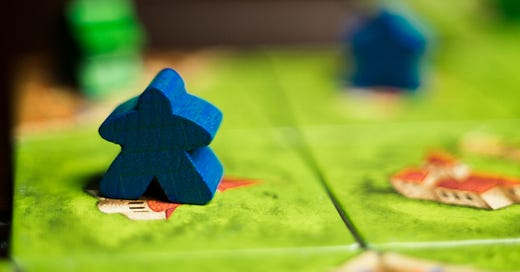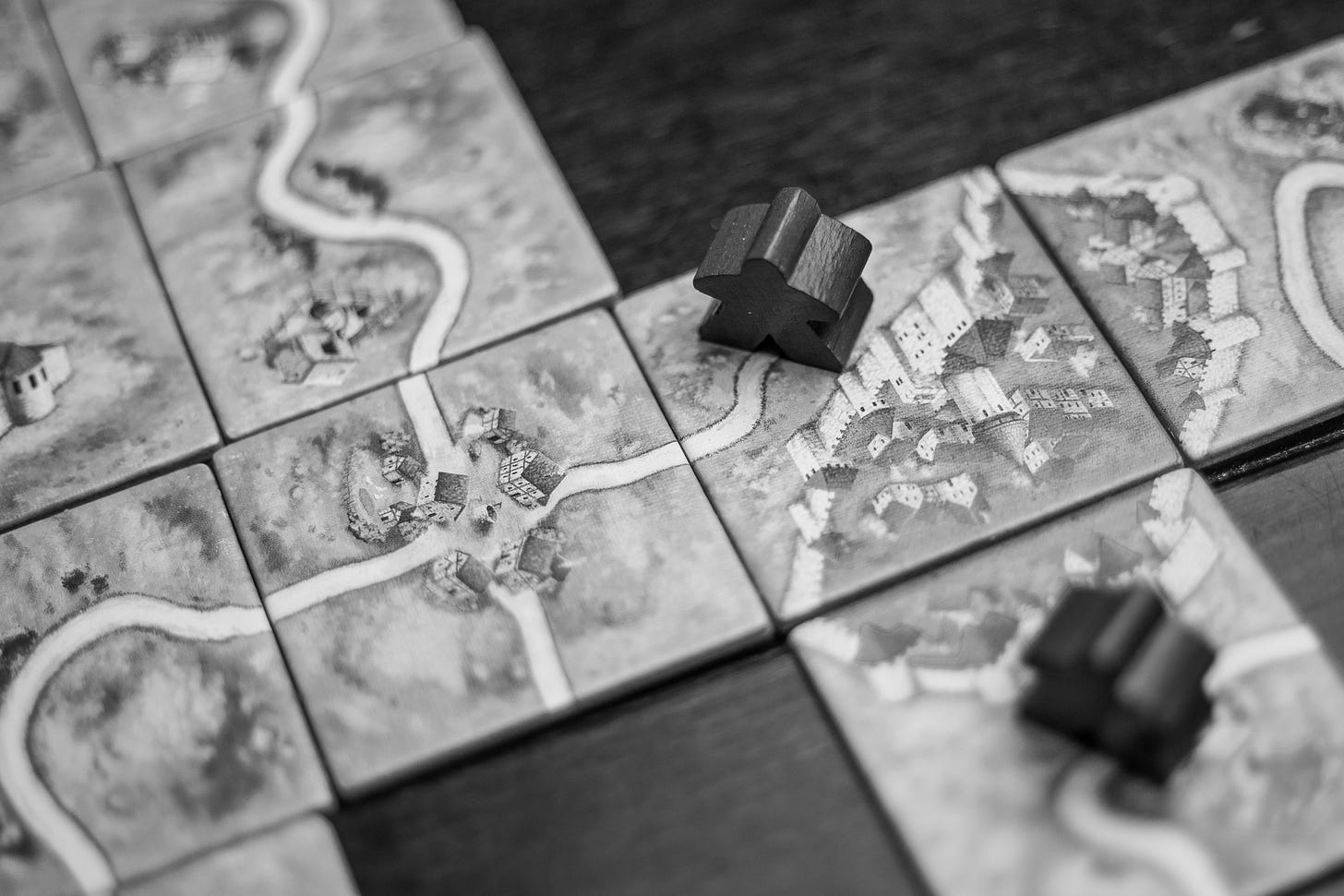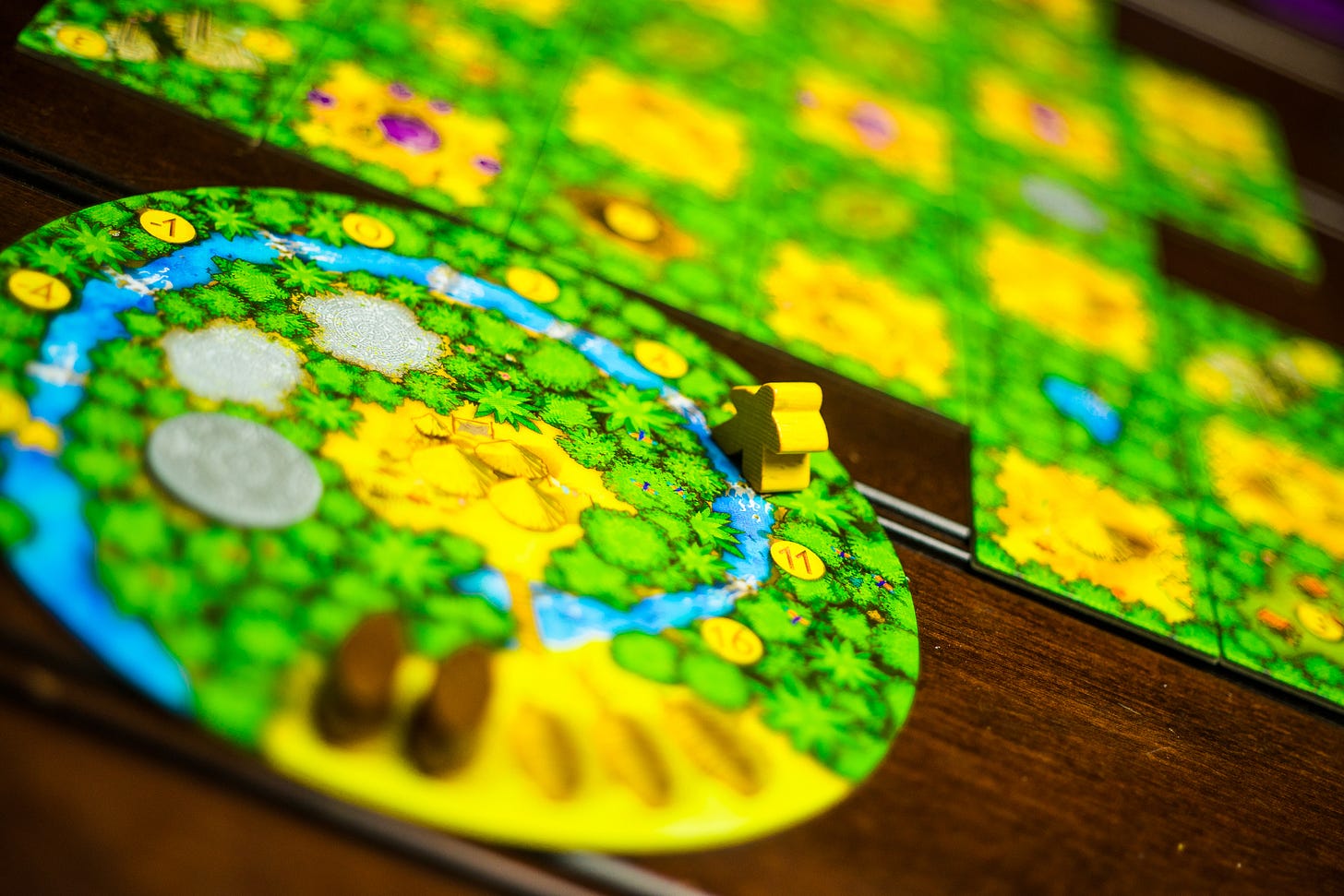Issue 17: History of the Meeple
Where did that wonderful portmanteau originate? Let's take a deep dive.
Hello all!
I hope you had a nice President’s Day, if you’re in the U.S. — and if you’re not, I hope you had a nice Monday. This newsletter is clearly coming out a day later than usual, and that’s why. Everyone deserves a day off now and again, right? Even you, from reading this email.
I don’t have too much to report on the gaming front this week. I did get a solo play of Sleeping Gods in, which was a good deal of fun; it’s a game I’m looking forward to diving into more. We didn’t play much in the way of games otherwise, as happens from time to time.
I did think it was very interesting to see that Asmodee has bought Board Game Arena. I don’t know that it’s a move that I’m quite understanding, aside from having a wide portfolio of board gaming companies and products under their belt. We’ll see where that goes, I suppose.
Anyway, let’s get on with this one. I quite like what I’ve written about here, because of course I do — I wrote it, after all. But really, it was interesting to research, and I hope I’ve done the topic justice.
If you’ve spent much time in the world of hobby board games, there’s a really good chance you’ve heard the word “meeple” tossed around. regularly. It’s a term for the little wooden figures in games, notably Carcassonne, and they are a particularly notable shape. The term, over time, has also been extended to apply to other small, wooden figures that are not people-shaped — animeeples, if they’re animals, for instance — but it’s a generally prominent thing.
Here, I’ll put a photo right here so you know what I mean.
See that little figure? That’s a meeple, and it’s generally considered the standard shape for a meeple. (Hereafter, I’ll use the term Standard Meeple to describe those things.)
Meeple as a concept is particularly interesting, because it’s not a term you’ll find in rulebooks when the term arose. Instead, it’s a term that emerged online, back in the days of Usenet, and well before anyone dreamt up Reddit, Twitter or Facebook.
The days of Usenet
To understand the origin of the term, we need to go back to the release of Carcassonne. The year was 2000, and hobby games were a growing-but-small hobby on the burgeoning internet. Community discussion platforms were popping up (phpBB had its first release in December that year, for instance), but a lot of discussion still came through Usenet, a distributed network of mostly text messages segmented into groups. For board games, rec.games.board was the primary gathering place, and real discussion happened there frequently.
A convention held in Essen, Germany (and popularly just known as Essen) is still a popular time to release new games, but it was one of the times to release games in the year 2000. People flocked there, the German game scene was blowing up, and it was a great way to kickstart your game’s popularity (only a little bit of a pun intended.)
Spotlight on Games, which purports to be the second-oldest board game site on the web still running (I’ll trust them on this one,) put together a list of games released at the 2000 edition of Essen. It’s very thorough — there are 109 games listed — and the writer’s second-top pick of the festival was Carcassonne. Another site, boardgame.de, put together a number of photos of the festival, too. It’s worth checking out.
All this is to provide context on the term, because it’s really an interesting illustration to see when it came to prominence. Essen 2000 took place on October 26. It was just a month later that we can find our first instance of “meeple” on the internet.
First recorded use
Most references point to one Alison Hansel as the source of the term meeple, and that’s surprisingly accurate for something that sounds like it could be largely folklore. We can actually trace the term, thanks in no small part to the internet archive and Google’s archive of Usenet posts.
In a Nov. 25 session report from South Shore Gamers, a gaming group in Walpole, Massachusetts, David Bernazzani wrote the following:
Carcassonne - I got my 2nd and 3rd plays of this light tile laying game tonight. I like it! Of course I'm a sucker for good tile laying games - usually they have just the right blend of luck and skill (and are usually fast). This one did not disappoint. There are 72 tiles - each turn you pick one up, lay it on the board (so that it makes sense - roads to roads, cities to cities, etc) and potentially place a little wee-wooden person (which we called 'Meeples' which I think stood for 'My People' but you'd have to ask Alison who coined it) on the tile just played. In this way, you try to score for completed roads, cities, cloisters and later in the game for farms (depending on where you put your Meeple, you created either a thief, knight, farmer, or monk to correspond with the terrain features of the tiles).
While I never had any reason to doubt the story that it was a shortening of “My People,” being able to see the term at its near-genesis is actually really remarkable. It’s such a prominent term now, and it’s a really interesting illustration of memetics as a concept. The term originated in one game group, its use was reported by one person, and now I wouldn’t hesitate to say the term is used by hundreds of thousands of people — if not more.
Man Vs Meeple put a great video in April 2019 that talks about the topic (which I only found searching for Alison, surprisingly enough,) and I’ll include some excerpts below.
I remember in the rules that the little figures were called followers, and that was not a very fun word at all. It seemed awkward. I don’t think we were calling them followers; I think we were calling them “my people,” or “I’m going to put my little dudes down here.” At one point, I was talking about moving my people somewhere, or what people I had where, and I said “meeple” — it just came out. It was funny, and so I said it again. That’s something I did — if I said something funny, I’d just say it again and again and again. We just started saying it; it was way better than follower. It was pleasant.
Again, it’s a great video, and she talks more about the term there, so do give it a watch.
Another side note — as we move on from Alison Hansel’s creation of the term into the spread of the term, it actually looks like she’s a published author — in 2007, she published a book of knitting projects for fans of Harry Potter. Very cool!
Spread
It’s not a coincidence that I mentioned Usenet above. Understanding how information spread in the days before social media as we recognize it now is important, because I think it makes the story all the more remarkable.
After its first recorded use in November 2000, it wasn’t long before it made its way over the rec.games.board newsgroup. On Dec. 7, 2000, user Andrew W. made reference when talking about Carcassonne strategies, citing Hansel’s name for the figures. (He also proposed an interesting variant on the game, which he called Meeple Manager, and I might just have to give it a try!) A day earlier, user David Vander Ark referenced the term, but did not cite Hansel.
The spread started there, but it took even more interesting paths. It wasn’t long until the Meeples Choice Award, voted on by the Spielfrieks mailing list, was founded. That, for me, is where it gets really interesting. I’ve had trouble tracking down the exact genesis of that (if anyone has a Spielfrieks archive for one reason or another, let me know!), but I did learn it was established in 2001. Being established such a short time after the term was coined, then adopting that term for the award, is something I find really fascinating. I don’t know how exactly the term traveled so broadly, but it has.
Of course, now, meeple is a very common term in the hobby. I mean, I have “meeple” in this newsletter name, and I’ve used that same name for my Instagram profile since 2016. Games are regularly released with “meeple” in the title, with Terror in Meeple City the first to gain real popularity, though several games predated it.
Changing meaning
One of the interesting parts of meeple history, for me, is the way the term evolved. Originally a way to say “my people” in a funny way, it has become essentially any wooden piece in a board game that represents a living entity. The animals in Agricola were reformed into “animeeples,” a term that has been in use since at least 2008, though I’m finding it tough to find earlier references to the term.
I will, with reckless abandon, refer to basically everything as a meeple these days, so long as it’s made of wood and not plastic or metal, and as long as it represents something living that you control. So a tree would not be a “tree meeple” unless I was feeling particularly impish, which I sometimes do. A mountain goat, though? It’s definitely a “mountain goateeple” or something similar. It’s also darn cute.
This is, honestly, fine. It’s even great. Of course, it requires a bit of caution as the hobby grows, because it’s important to not bog people down with weird, unimportant jargon. Meeple, though? I don’t know. For me, there was something exciting when I first really started using a hobbyist term, and I wouldn’t discount that potential feeling.
In keeping with the theme of meeples, here are some of my favorite meeples:
Agricola, the Sheeple
Carcassonne, The Standard Meeple — the grandparent of all meeples
Mountain Goats, the Mountain Goat Meeple
New York Zoo, the Flamingo Meeple
Raiders of the West Kingdom, the Viking Meeple
Root, the Vagabond Meeple








